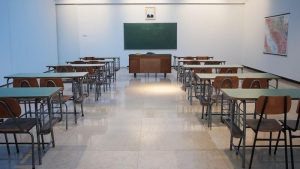Opinion: We Should Not Open Up Jesuit
December 18, 2020
A few months ago, I would have agreed that school should be back in session. This opinion was not backed by any research but simply a selfish musing. School has been closed since March 2020 and we have now endured almost nine months of quarantine and isolation. While I would love to return to school to see my peers and be able to participate in typical senior year activities, I know it is not safe.
With COVID-19 spreading so rapidly, the idea of returning to school is in the far future. While masks, home room lunch periods, and health screenings are necessary precautions, they would only limit the spread.
The requirement for students to wear a mask at all times may be helpful, however, there is no guarantee that masks will in fact stay intact through the school day. Students will need to remove their masks to eat and drink and often masks are removed in restroom settings. Teachers cannot be watching students at all times and we do not have the resources to ensure that masks stay on during school hours.
However, even if students keep their masks on at all times, studies show that masks are not 100% effective. In an article published by Stephanie Pappias titled “Do face masks really reduce coronavirus spread?” the effectiveness of different kinds of mask is explained.
“CDC also does not recommend surgical masks for the general public. These masks don’t seal against the face but do include non-woven polypropylene layers that are moisture resistant. In a surgical mask, about 70% of the outside air moves through the mask and about 30% travels around the sides,” Pappias wrote. “That leaves fabric masks, which currently are recommended for general use by the CDC. Fabric masks also allow air in around the sides, but lack non-woven, moisture-repelling layers. They impede only about 2% of airflow in.”
No matter what mask is worn, there is always some airflow that is let in. As Stephanine Pappias explains, you may be at a lower risk depending on which mask you choose to wear, but the underlying fact is that masks do not work all of the time. The only method that is proven to be 100% effective is to stay at home.
Masks are to be used as an add on for safety. It is a common misconception that masks are the only precaution that people must take. Stephanie Pappias elaborates on this.
“‘Putting a face mask on does not mean that you stop the other practices’” Pappias wrote quoting Assistant Director of Public Health in the Office for Science and Technology Policy May C. Chu. “‘It does not mean you get closer to people, it does not mean you don’t have to wash your hands as often and you can touch your face. All of that still is in place, this is just an add-on.’”
At school it will be difficult to maintain a reliable distance from every student or faculty member that you will pass through the day. As May C. Chu stated, it is not enough to just wear a mask, you must still maintain social distances.
In an ideal world, masks always work. Even so, students are still at risk once they leave school and are exposed to those who are not following CDC protocol. While you may think that you are interacting only with your “bubble,” your bubble is often larger than you think. If even one person interacts with someone without their mask who is not in your bubble, they could risk contracting and spreading the virus.
There is also a large opinion that even though we are not able to go back to school that we should be able to participate in sports. In my opinion, we should focus on getting back to school first. With constant motion (and in some cases physical contact) it is easy for masks to slip while in close proximity, not to mention athletes need to lower their mask to drink water. In the event that an athletes mask does slip while they are infected with the virus, they could spread it to their whole team, who will then likely spread it even further. This fact is evidenced by the numerous college football games that have been cancelled due to COVID-19. While I am disappointed to potentially be missing my track season, as I am sure many other students are, it is too risky to even practice.
Of course, I realize that the greater majority of high school students are young, healthy, and will not be deeply impacted by the virus. This is not the reason to take precautions. Many students live with or frequently come in contact with those who are at high risk. I visit my grandparents often and know because they are compromised, I need to be extra careful. Even if you don’t, someone you come in contact with might so it is important to always be cautious.
The only way it is safe to return to school, sports, and all other activities is when there is an effective vaccine that is easily accessible. Without one, an airborne virus is too difficult to contain with a group of people as large as a high school. I know that everyone wants to return to school, but right now, it is not safe.
Sources:



